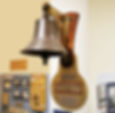
The Lucy was East London's first suction dredger, named after Lucy Schermbrucker, wife of Colonel Schermbrucker, who was the Member of Parliament for King William's Town.
She arrived at the port in May 1886, went to work in July although she was only officially inaugurated in November that year. Her presence, however, was much needed and she had lots of work to do.
Sir John Coode's harbour scheme which had started in 1872 provided for training walls along both banks of the Buffalo River. The theory was that heavy rain would cause a "freshet" or minor flood to scour the river and remove the sand-bar from the mouth, dumping it out to sea.

The period from 1872 until 1887, however, was a time of protracted drought and so the bar remained fairly static. The arrival of the Lucy was therefore most opportune.
From August to November 1885 the river mouth had shoaled up almost completely and became nearly dry at low tide. Indeed, people could walk across the Buffalo River mouth without even getting their feet wet, which is not good for a harbour.
The dredger began work in July 1886 and, by the end of the year, she had already made good progress, having straightened the channel as far as the bar, and even that was showing a marked improvement. By the end of 1887, the depth of water had already reached eleven feet at low tide.
So successful was the Lucy that, in February 1888, Sir John Coode suggested a second dredger be acquired. The entire channel could then be maintained at a depth of some 15 feet which, he said, would place the harbour "in a first class condition".
The idea was eventually taken up and the Sir Gordon arrived in February 1891. It was named after Sir John Gordon Sprigg, East London's senior Member of Parliament.
Unfortunately, the Lucy would not survive much beyond the arrival of the Sir Gordon. In November 1895, she struck some submerged blocks and was wrecked.
The official enquiry into the accident indicated that she had dragged anchor because her cables were of insufficient length and there had been no look-out on duty at the time. The dredger had eventually come broadside to the swell which had swept her on to the rocks.
The ship's bell eventually found its way to the Anglican Church at Kidd's Beach, some 30 miles from East London. There it served as a church bell but was donated to the East London Museum in 1885.
It was a sad end to a vessel which had been largely responsible for initiating a period of unprecedented prosperity for East London.
Author: Dr Keith Tankard
